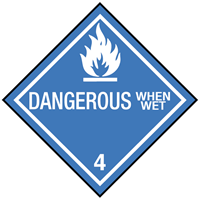
 Print
Print
Chemical Datasheet
ETHYL ALUMINUM DICHLORIDE |


|
Chemical Identifiers
| CAS Number |
UN/NA Number |
DOT Hazard Label |
USCG CHRIS Code |
- 563-43-9

|
|
- Spontaneously Combustible
- Dangerous When Wet
|
|
| NIOSH Pocket Guide |
International Chem Safety Card |
|
none
|
none
|
NFPA 704
General Description
A colorless to light-yellow heated liquid. Freezing point 90°F. (USCG, 1999)
Hazards
Reactivity Alerts
- Strong Reducing Agent
- Water-Reactive
- Pyrophoric
Air & Water Reactions
Highly flammable. Ignites when exposed to air. Reacts violently with water or moisture in air forming hydrogen chloride fumes and flammable ethane gas (Rose 1961).
Fire Hazard
Special Hazards of Combustion Products: Intense smoke may cause metal-fume fever. Irritating hydrogen chloride also formed.
Behavior in Fire: Contact with water applied to adjacent fires will cause formation of irritating smoke containing aluminum oxide and hydrogen chloride. (USCG, 1999)
Health Hazard
Inhalation of smoke from fire causes metal-fume fever (flu-like symptoms); acid fumes irritate nose and throat. Contact with liquid (which is spontaneously flammable) causes severe burns of eyes and skin. (USCG, 1999)
Reactivity Profile
Organometallics, such as ETHYL ALUMINUM DICHLORIDE, are reactive with many other groups. Incompatible with acids and bases. Organometallics are good reducing agents and therefore incompatible with oxidizing agents. Often reactive with water to generate toxic or flammable gases. Organometallics containing halogens (fluorine, chlorine, bromine, iodine) bonded to the metal typically with generate gaseous hydrohalic acids (HF, HCl, HBr, HI) with water.
Belongs to the Following Reactive Group(s)
- Metal Hydrides, Metal Alkyls, Metal Aryls, and Silanes
Potentially Incompatible Absorbents
No information available.
Response Recommendations
Isolation and Evacuation
Excerpt from ERG Guide 135 [Substances - Spontaneously Combustible]:
IMMEDIATE PRECAUTIONARY MEASURE: Isolate spill or leak area in all directions for at least 50 meters (150 feet) for liquids and at least 25 meters (75 feet) for solids.
SPILL: Increase the immediate precautionary measure distance, in the downwind direction, as necessary.
FIRE: If tank, rail tank car or highway tank is involved in a fire, ISOLATE for 800 meters (1/2 mile) in all directions; also, consider initial evacuation for 800 meters (1/2 mile) in all directions. (ERG, 2024)
Firefighting
Fire Extinguishing Agents Not to Be Used: Water, foam, dry chemicals, halogenated agents, or carbon dioxide
Fire Extinguishing Agents: Inert dry powders such as dry graphite, soda ash, sand, limestone. (USCG, 1999)
Non-Fire Response
Neutralizing Agents for Acids and Caustics: Rinse with sodium bicarbonate or lime solution. (USCG, 1999)
Protective Clothing
Full protective clothing, preferably of aluminized glass cloth; goggles, face shield, gloves; in case of fire, all-purpose canister or self-contained breathing apparatus. (USCG, 1999)
DuPont Tychem® Suit Fabrics
No information available.
First Aid
INHALATION: only fumes from fire need be considered; metal-fume fever is not critical and lasts less than 36 hrs.; irritation of nose and throat by acid vapors may require treatment by a physician.
EYES: flush gently with water for 15 min.; treat burns if fire occurred; get medical attention.
SKIN: wash with water; treat burns caused by fire; get medical attention. (USCG, 1999)
Physical Properties
Flash Point: data unavailable
Lower Explosive Limit (LEL): data unavailable
Upper Explosive Limit (UEL): data unavailable
Autoignition Temperature:
Ignites spontaneously in air at ambient temperature.
(USCG, 1999)
Melting Point:
90°F
(USCG, 1999)
Vapor Pressure: data unavailable
Vapor Density (Relative to Air): data unavailable
Specific Gravity:
1.227
at 95°F
(USCG, 1999)
- Denser than water; will sink
Boiling Point:
381°F
at 760 mmHg
(USCG, 1999)
Molecular Weight:
130
(USCG, 1999)
Water Solubility: data unavailable
Ionization Energy/Potential: data unavailable
IDLH: data unavailable
AEGLs (Acute Exposure Guideline Levels)
No AEGL information available.
ERPGs (Emergency Response Planning Guidelines)
No ERPG information available.
PACs (Protective Action Criteria)
| Chemical |
PAC-1 |
PAC-2 |
PAC-3 |
| Dichloroethylaluminum (563-43-9)
|
28 mg/m3 |
310 mg/m3 |
1800 mg/m3 |
(DOE, 2024)
Regulatory Information
EPA Consolidated List of Lists
No regulatory information available.
CISA Chemical Facility Anti-Terrorism Standards (CFATS)
No regulatory information available.
OSHA Process Safety Management (PSM) Standard List
No regulatory information available.
Alternate Chemical Names
- ALUMINUM ETHYL DICHLORIDE
- EADC
- ETHYL ALUMINUM DICHLORIDE
- ETHYLALUMINUM DICHLORIDE



 Print
Print

